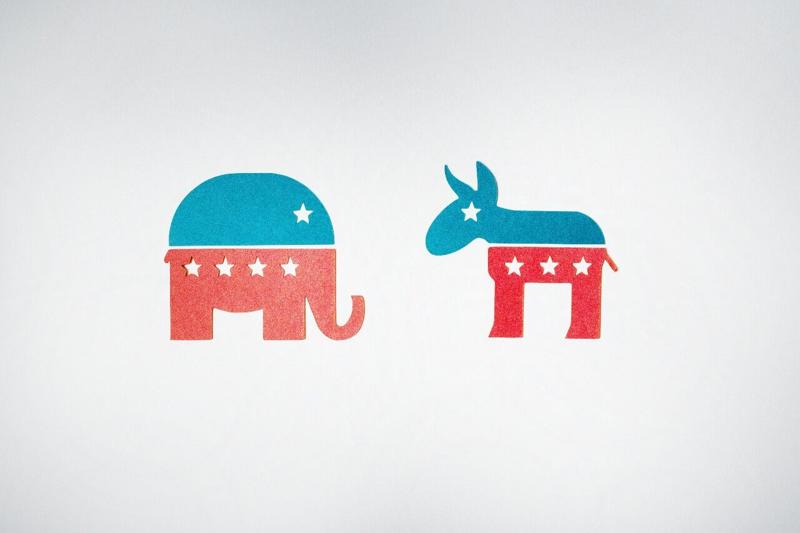Democrats and Republicans are battling in races around the country for majorities in the U.S. House and Senate, but with just days until Election Day, who will get control is still up for grabs.
Pollsters often ask Americans whether they want Democrats or Republicans in charge of Congress.
But those generic ballots aren’t much help in discerning who could come away with control of the House and Senate this time around.
FiveThirtyEight’s poll aggregation shows the two parties in a dead tie.
Betting markets, on the other hand, are anticipating slight GOP majorities in the House and Senate.
The prediction exchange market Polymarket shows a 55% chance Republicans control the House and an 83% chance Republicans control the Senate.
In the Senate, 33 seats are up for election on Nov. 5.
That includes 19 seats held by Democrats and 10 seats held by Republicans.
The remaining 4 seats are held by Independents that lean Democrat, namely Sens. Kyrsten Sinema, Bernie Sanders, Angus King and Joe Manchin.
Both Manchin and Sinema, formerly Democrats, have announced they will retire from the Senate after this term.
Retirements in more closely divided states like Arizona and West Virginia can make it harder for the elected parties, who rely heavily on name recognition and the power of incumbency, to remain in office.
According to Real Clear Politics’ polling average, there are seven “toss-up” races in the Senate, and six of them are seats currently held by Democrats.
Notably, Sen. Jon Tester, D-Mont., is up for reelection, but his seat is currently classified as “lean GOP.”
No Republican Senate seats are considered “lean Democrat.”
Sens. Rick Scott, R-Fla., and Deb Fischer, R-Neb., are doing better than the toss ups but not in “safe” races, putting them as the Republicans in the “lean Republican” races.
On the Democratic side, Sen. Martin Heinrich, D-N.M., is in the same boat, as is the open Senate seat in Michigan, previously held by longtime Senator Debbie Stabenow before her announcement of retirement.
Sen. Josh Haley, R-Mo., is not quite “safe” but is in the “likely GOP” category, according to RCP, up by around 10 points in the latest polls.
Sens. Tim Kaine, D-Va., and Bob Menendez, D-N.J., are in a similar position in their respective races.
In the House, nearly all 435 members are up for reelection.
However, according to Ballotpedia, 45 House members are either retiring, seeking other offices, or lost their primary races. That number is comparable to previous election cycles, with about 50 doing the same in 2022 and 2020.
The majority of House races are easily in the camp of one party or the other, but there are more than enough close races to keep the fate of the House in question.
According to RCP, 42 races are in the toss-up category, 23 of them held by Democrats and 18 held by Republicans.
The presidential election has a major impact on the down-ballot races in the House and Senate, with higher turnout and voters more likely to be swayed in favor of the party for which they are voting for president.
National polling shows Vice President Kamala Harris and former President Donald Trump nearly tied, though Harris has a slight edge within the margin of error. In the seven closest swing states, however, Trump holds narrow leads within the margin of error as well.
Trump is doing better with Hispanics and Black voters than other recent Republicans, which could help Republican candidates in some states depending on their demographics. Harris is doing much better than Trump with women, which could help candidates of her own party win over that demographic in key races.
Either party needs 218 members to secure the majority in the House.
Campaign veteran and former Mitt Romney spokesperson Ryan Williams told The Center Square that voter turnout is radically different in a presidential election year and that depending on the unique demographics of each race, Harris and Trump could help or hurt the lawmakers’ running.
“Trump is holding his own in the presidential race, but he remains deeply unpopular in deep blue states like New York and California, where there are several Republican members fighting for their political lives,” Williams, now at Targeted Victory, told The Center Square.
“He’s a liability for them,” he continued. “And with a House that has got a 4-seat majority for Republicans, those districts could make the difference.”
“Trump is generally more problematic for down-ballot Republicans given where they are from … he drives Democratic turnout, which could spell trouble for some Republicans in purple districts or blue states.
“Now conversely, Harris is a drag for some Democrats,” he continued. “Sherrod Brown is going to have to hover above political gravity in Ohio given that Trump is going to win that state handily. His only hope is if Trump wins the state by 8 points or less. If he wins by more than 8, it’s over.”
Trump does have support in some purple states, driving some Democrats running for reelection, like Sen. Tammy Baldwin, D-Wisc., and Sen. Bob Casey, D-Penn., to feature Trump in recent campaign ads.
“If [Trump] were utterly toxic in these purple states, Democrats wouldn’t be putting him in their ads,” Williams said.







